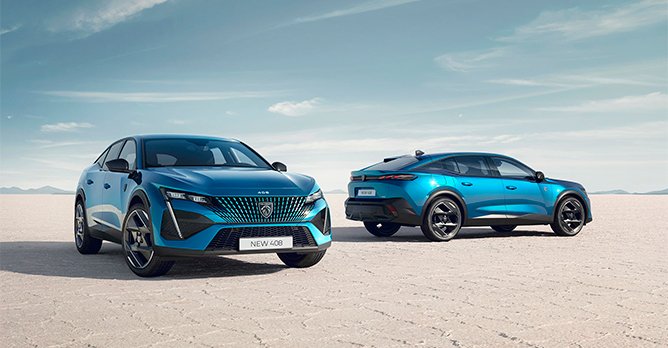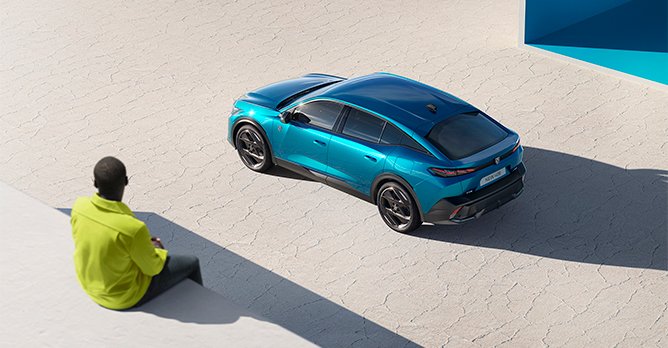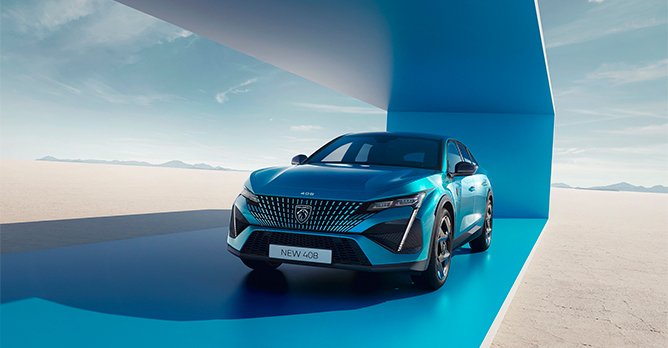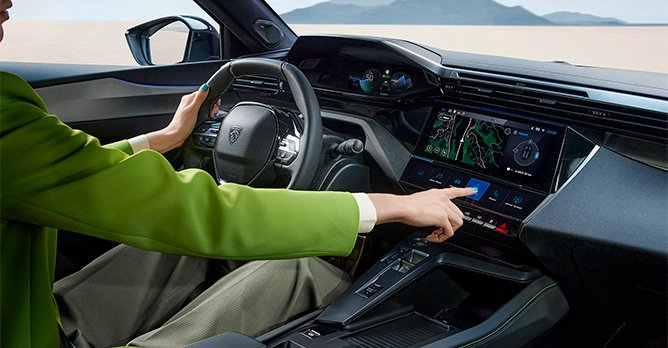Peugeot's brand new model, the 408, isn't a sedan nor an SUV
22 Jun 2022|4,052 views
Behold: A new species of Peugeot is on the horizon.
To be clear, these are the words of the French marque - not ours. Yet we would be hard pressed not to concur that the svelte, 'dynamic fastback saloon' in these pictures is nothing like we have seen from Peugeot before.
The all new Peugeot 408 is not to be confused with the 408 Sedan (predominantly in service of the Chinese market) that serves as the three-boxed foil to the 308 Hatchback. Rather, this is the European market model that's set to go out into the rest of the world. It's also being primed as the next big thing in the French automaker's line-up.
In the unveiling of the car, descriptive terms such as 'disruptive' and 'inventive' were used to describe its relatively left-of-centre design approach. This will clearly be its most immediate draw; it has the fundamental design cues of a fastback saloon, but with more ground clearance and a higher seating position than one.
The 408 is supposed to reside near the top end of the C-segment (occupied by cars like the Volkswagen Golf) and shares a platform with Peugeot's own 308. But Peugeot says it is also targeting buyers normally shopping in the D-segment right above. That's populated with bestsellers like the Audi A4 and BMW 3 Series. Interior space for the 408 will be generous, considering the car's 2,790mm wheelbase.

 The 408's 20-inch alloy wheels feature 'disruptive geometrical graphics', with their own distinctive visual character when static and on the move By not firmly committing to either sedan or SUV territory, Peugeot states that the 408 was designed without any specific competitors in mind. If we're being honest, however, at least one car has also blended the fastback silhouette with a slightly raised ride height in recent memory.
The 408's 20-inch alloy wheels feature 'disruptive geometrical graphics', with their own distinctive visual character when static and on the move By not firmly committing to either sedan or SUV territory, Peugeot states that the 408 was designed without any specific competitors in mind. If we're being honest, however, at least one car has also blended the fastback silhouette with a slightly raised ride height in recent memory.
Nonetheless, there's no denying the 408's visual distinction. The athleticism of the car is marked by its wide stance and long bonnet. DRL 'fangs', coupled with the brand's latest grille (which, by the way, matches the car's paintwork colour) make it clear which French marque this is, as do the claw-like LED clusters for the rear lights. Also striking are the 'disruptive geometrical graphics' on the 20-inch alloy wheels, which have their own visual characters both when static and when on the move.
Most intriguing, perhaps, are 'cat ears' found towards the end of the car's roof. These enhance the 'feline' characteristic of the car's design, but they apparently also improve the aerodynamics of the 408.
In line with the move towards electrification, Peugeot has decided to give the 408 a couple of plug-in hybrid variants, producing 180bhp and 225bhp. A pure petrol-engined variant which appears to have been more clearly outlined for global markets outside of Europe will also be offered, producing 130bhp.
Unsurprisingly, an all-electric BEV model will follow in the future, but what's quite different this time is the fact that the 408 will not come with a diesel engine - a move that's quite significant considering that diesels are still widely used in Peugeot's native Europe. The car will also not be offered with a manual transmission. Instead, all variants of the 408 will feature an eight-speed automatic.

 Peugeot is pledging its faith in the appeal of the 408 not in spite of, but because of its unique positioning In teasers leading up to the car's big reveal, Peugeot made great efforts to outline the immense resources already poured into the car. The 408 has apparently clocked more than a million kilometres in road tests across a variety of treacherous conditions, in order to put the car through its paces before it reaches customers.
Peugeot is pledging its faith in the appeal of the 408 not in spite of, but because of its unique positioning In teasers leading up to the car's big reveal, Peugeot made great efforts to outline the immense resources already poured into the car. The 408 has apparently clocked more than a million kilometres in road tests across a variety of treacherous conditions, in order to put the car through its paces before it reaches customers.
A good level of tech will also be on offer with the firm's latest-gen i-Cockpit. In addition, six cameras and nine radars will power the 408's driving assistance systems.
When asked whether the 408 will be a volume seller like the 308 Hatchback - considering its experimental nature - Jerome Micheron, the Head of Product, states that the brand believes the fastback-saloon has the allure (and will deliver the quality) to achieve a good level of mass market appeal.
The Peugeot 408 is set to be launched officially at the end of 2022, and will arrive at dealerships in early 2023.
To be clear, these are the words of the French marque - not ours. Yet we would be hard pressed not to concur that the svelte, 'dynamic fastback saloon' in these pictures is nothing like we have seen from Peugeot before.
The all new Peugeot 408 is not to be confused with the 408 Sedan (predominantly in service of the Chinese market) that serves as the three-boxed foil to the 308 Hatchback. Rather, this is the European market model that's set to go out into the rest of the world. It's also being primed as the next big thing in the French automaker's line-up.
In the unveiling of the car, descriptive terms such as 'disruptive' and 'inventive' were used to describe its relatively left-of-centre design approach. This will clearly be its most immediate draw; it has the fundamental design cues of a fastback saloon, but with more ground clearance and a higher seating position than one.
The 408 is supposed to reside near the top end of the C-segment (occupied by cars like the Volkswagen Golf) and shares a platform with Peugeot's own 308. But Peugeot says it is also targeting buyers normally shopping in the D-segment right above. That's populated with bestsellers like the Audi A4 and BMW 3 Series. Interior space for the 408 will be generous, considering the car's 2,790mm wheelbase.

Nonetheless, there's no denying the 408's visual distinction. The athleticism of the car is marked by its wide stance and long bonnet. DRL 'fangs', coupled with the brand's latest grille (which, by the way, matches the car's paintwork colour) make it clear which French marque this is, as do the claw-like LED clusters for the rear lights. Also striking are the 'disruptive geometrical graphics' on the 20-inch alloy wheels, which have their own visual characters both when static and when on the move.
Most intriguing, perhaps, are 'cat ears' found towards the end of the car's roof. These enhance the 'feline' characteristic of the car's design, but they apparently also improve the aerodynamics of the 408.
In line with the move towards electrification, Peugeot has decided to give the 408 a couple of plug-in hybrid variants, producing 180bhp and 225bhp. A pure petrol-engined variant which appears to have been more clearly outlined for global markets outside of Europe will also be offered, producing 130bhp.
Unsurprisingly, an all-electric BEV model will follow in the future, but what's quite different this time is the fact that the 408 will not come with a diesel engine - a move that's quite significant considering that diesels are still widely used in Peugeot's native Europe. The car will also not be offered with a manual transmission. Instead, all variants of the 408 will feature an eight-speed automatic.

A good level of tech will also be on offer with the firm's latest-gen i-Cockpit. In addition, six cameras and nine radars will power the 408's driving assistance systems.
When asked whether the 408 will be a volume seller like the 308 Hatchback - considering its experimental nature - Jerome Micheron, the Head of Product, states that the brand believes the fastback-saloon has the allure (and will deliver the quality) to achieve a good level of mass market appeal.
The Peugeot 408 is set to be launched officially at the end of 2022, and will arrive at dealerships in early 2023.
Behold: A new species of Peugeot is on the horizon.
To be clear, these are the words of the French marque - not ours. Yet we would be hard pressed not to concur that the svelte, 'dynamic fastback saloon' in these pictures is nothing like we have seen from Peugeot before.
The all new Peugeot 408 is not to be confused with the 408 Sedan (predominantly in service of the Chinese market) that serves as the three-boxed foil to the 308 Hatchback. Rather, this is the European market model that's set to go out into the rest of the world. It's also being primed as the next big thing in the French automaker's line-up.
In the unveiling of the car, descriptive terms such as 'disruptive' and 'inventive' were used to describe its relatively left-of-centre design approach. This will clearly be its most immediate draw; it has the fundamental design cues of a fastback saloon, but with more ground clearance and a higher seating position than one.
The 408 is supposed to reside near the top end of the C-segment (occupied by cars like the Volkswagen Golf) and shares a platform with Peugeot's own 308. But Peugeot says it is also targeting buyers normally shopping in the D-segment right above. That's populated with bestsellers like the Audi A4 and BMW 3 Series. Interior space for the 408 will be generous, considering the car's 2,790mm wheelbase.

 The 408's 20-inch alloy wheels feature 'disruptive geometrical graphics', with their own distinctive visual character when static and on the move By not firmly committing to either sedan or SUV territory, Peugeot states that the 408 was designed without any specific competitors in mind. If we're being honest, however, at least one car has also blended the fastback silhouette with a slightly raised ride height in recent memory.
The 408's 20-inch alloy wheels feature 'disruptive geometrical graphics', with their own distinctive visual character when static and on the move By not firmly committing to either sedan or SUV territory, Peugeot states that the 408 was designed without any specific competitors in mind. If we're being honest, however, at least one car has also blended the fastback silhouette with a slightly raised ride height in recent memory.
Nonetheless, there's no denying the 408's visual distinction. The athleticism of the car is marked by its wide stance and long bonnet. DRL 'fangs', coupled with the brand's latest grille (which, by the way, matches the car's paintwork colour) make it clear which French marque this is, as do the claw-like LED clusters for the rear lights. Also striking are the 'disruptive geometrical graphics' on the 20-inch alloy wheels, which have their own visual characters both when static and when on the move.
Most intriguing, perhaps, are 'cat ears' found towards the end of the car's roof. These enhance the 'feline' characteristic of the car's design, but they apparently also improve the aerodynamics of the 408.
In line with the move towards electrification, Peugeot has decided to give the 408 a couple of plug-in hybrid variants, producing 180bhp and 225bhp. A pure petrol-engined variant which appears to have been more clearly outlined for global markets outside of Europe will also be offered, producing 130bhp.
Unsurprisingly, an all-electric BEV model will follow in the future, but what's quite different this time is the fact that the 408 will not come with a diesel engine - a move that's quite significant considering that diesels are still widely used in Peugeot's native Europe. The car will also not be offered with a manual transmission. Instead, all variants of the 408 will feature an eight-speed automatic.

 Peugeot is pledging its faith in the appeal of the 408 not in spite of, but because of its unique positioning In teasers leading up to the car's big reveal, Peugeot made great efforts to outline the immense resources already poured into the car. The 408 has apparently clocked more than a million kilometres in road tests across a variety of treacherous conditions, in order to put the car through its paces before it reaches customers.
Peugeot is pledging its faith in the appeal of the 408 not in spite of, but because of its unique positioning In teasers leading up to the car's big reveal, Peugeot made great efforts to outline the immense resources already poured into the car. The 408 has apparently clocked more than a million kilometres in road tests across a variety of treacherous conditions, in order to put the car through its paces before it reaches customers.
A good level of tech will also be on offer with the firm's latest-gen i-Cockpit. In addition, six cameras and nine radars will power the 408's driving assistance systems.
When asked whether the 408 will be a volume seller like the 308 Hatchback - considering its experimental nature - Jerome Micheron, the Head of Product, states that the brand believes the fastback-saloon has the allure (and will deliver the quality) to achieve a good level of mass market appeal.
The Peugeot 408 is set to be launched officially at the end of 2022, and will arrive at dealerships in early 2023.
To be clear, these are the words of the French marque - not ours. Yet we would be hard pressed not to concur that the svelte, 'dynamic fastback saloon' in these pictures is nothing like we have seen from Peugeot before.
The all new Peugeot 408 is not to be confused with the 408 Sedan (predominantly in service of the Chinese market) that serves as the three-boxed foil to the 308 Hatchback. Rather, this is the European market model that's set to go out into the rest of the world. It's also being primed as the next big thing in the French automaker's line-up.
In the unveiling of the car, descriptive terms such as 'disruptive' and 'inventive' were used to describe its relatively left-of-centre design approach. This will clearly be its most immediate draw; it has the fundamental design cues of a fastback saloon, but with more ground clearance and a higher seating position than one.
The 408 is supposed to reside near the top end of the C-segment (occupied by cars like the Volkswagen Golf) and shares a platform with Peugeot's own 308. But Peugeot says it is also targeting buyers normally shopping in the D-segment right above. That's populated with bestsellers like the Audi A4 and BMW 3 Series. Interior space for the 408 will be generous, considering the car's 2,790mm wheelbase.

Nonetheless, there's no denying the 408's visual distinction. The athleticism of the car is marked by its wide stance and long bonnet. DRL 'fangs', coupled with the brand's latest grille (which, by the way, matches the car's paintwork colour) make it clear which French marque this is, as do the claw-like LED clusters for the rear lights. Also striking are the 'disruptive geometrical graphics' on the 20-inch alloy wheels, which have their own visual characters both when static and when on the move.
Most intriguing, perhaps, are 'cat ears' found towards the end of the car's roof. These enhance the 'feline' characteristic of the car's design, but they apparently also improve the aerodynamics of the 408.
In line with the move towards electrification, Peugeot has decided to give the 408 a couple of plug-in hybrid variants, producing 180bhp and 225bhp. A pure petrol-engined variant which appears to have been more clearly outlined for global markets outside of Europe will also be offered, producing 130bhp.
Unsurprisingly, an all-electric BEV model will follow in the future, but what's quite different this time is the fact that the 408 will not come with a diesel engine - a move that's quite significant considering that diesels are still widely used in Peugeot's native Europe. The car will also not be offered with a manual transmission. Instead, all variants of the 408 will feature an eight-speed automatic.

A good level of tech will also be on offer with the firm's latest-gen i-Cockpit. In addition, six cameras and nine radars will power the 408's driving assistance systems.
When asked whether the 408 will be a volume seller like the 308 Hatchback - considering its experimental nature - Jerome Micheron, the Head of Product, states that the brand believes the fastback-saloon has the allure (and will deliver the quality) to achieve a good level of mass market appeal.
The Peugeot 408 is set to be launched officially at the end of 2022, and will arrive at dealerships in early 2023.
Latest COE Prices
November 2025 | 2nd BIDDING
NEXT TENDER: 03 Dec 2025
CAT A$109,000
CAT B$129,890
CAT C$76,389
CAT E$125,001
View Full Results Thank You For Your Subscription.

























